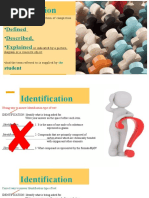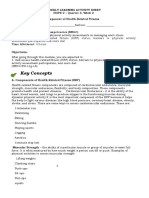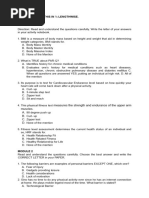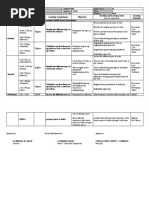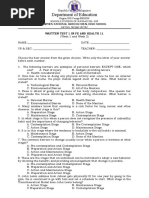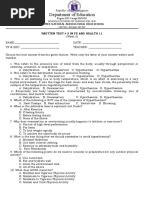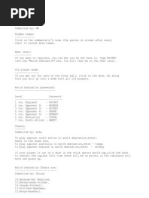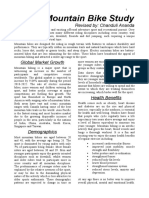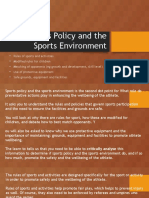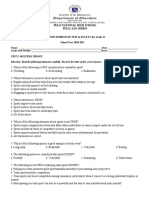Department of Education: Republic of The Philippines
Department of Education: Republic of The Philippines
Uploaded by
WilliamAporboCopyright:
Available Formats
Department of Education: Republic of The Philippines
Department of Education: Republic of The Philippines
Uploaded by
WilliamAporboOriginal Title
Copyright
Available Formats
Share this document
Did you find this document useful?
Is this content inappropriate?
Copyright:
Available Formats
Department of Education: Republic of The Philippines
Department of Education: Republic of The Philippines
Uploaded by
WilliamAporboCopyright:
Available Formats
Republic of the Philippines
Department of Education
Region XIII-Caraga REGION
SCHOOLS DIVISION OF SURIGAO DEL SUR
CARMEN NATIONAL AGRICULTURAL HIGH SCHOOL
Carmen, Surigao del Sur
WRITTEN TEST 2 IN PE AND HEALTH 11
(Week 3 and Week 4)
NAME:________________________________ DATE: ____________________________
YR & SEC: ____________________________ TEACHER: ________________________
Choose the best answer from the given choices. Write only the letter of your answer before each
number.
1. The following are examples of aerobic type of physical activities EXCEPT:
A. Walking B. Running C. Singing D. Cycling/biking
2. This refers to the number of times a physical activity is done in each week.
A. Frequency B. Intensity C. Time D. Type
3. Which of the following is an example of a moderate-intensity physical activity?
A. Competitive sports and game (e.g. Traditional Games, Football, Volleyball, Hockey,
Basketball).
B. Carrying/moving heavy loads (>20 kg)
C. Walking/climbing briskly up a hill
D. Housework and domestic chores
4. The rate at which the activity is performed is called ___________.
A. Intensity B. Specificity C. Progression D. Reversibility
5. Exercise that do not maintain a raised heart rate are ______________?
A. Aerobic B. Atrophic C. Anaerobic D. Hypertrophic
6. Which of the following motor skills is often used for active leisure activity?
A. Netball pass B. Hockey flick C. Running D. Triple jump
7. Which of the following is NOT a characteristic of a balanced, healthy lifestyle?
A. Exercising regularly
B. Drinking plenty of water regularly
C. Only drinking 5 units of alcohol per day
D. Eating plenty of fruits and vegetables
8. A healthy, active lifestyle helps to improve and maintain mental health. Which of the
following is an example of an improvement in mental health?
A. Better stamina to keep going
B. More skills to carry out specific physical activities
C. You live longer
D. More able to think positively
9. Cardiovascular endurance is a component of fitness and a healthy balanced lifestyle. Which
of the following describes cardiovascular endurance most accurately?
A. The ability of the heart and lungs to cope with exercise over a period of time
B. The ability of the muscles to perform over a period of time
C. The amount of force a muscle can exert against resistance
D. The ability to change the body’s movement quickly
10. The purpose of the initial fitness assessment, pretest, is:
A. To compare students to each other
B. To identify your strengths and weaknesses
C. To provide you a basis for setting realistic goals
D. B and C are both correct
11. Why should one need to pace his participation in physical activities?
A. So that he/she will benefit more from his physical activity.
B. So that he/she will not be injured.
C. Both a and b.
D. None of the above.
12. What is the practical way to know your level of effort in a physical activity?
A. By singing or talking.
B. By eating.
C. By drinking water.
D. All of the above
13. What is the target zone for aerobic activity?
A. Between 10 to 14. C. Between 25 to 19.
B. Between 16 to 20. D. Between 12 to 16.
14. The following are the steps in getting your target heart rate. Arrange it in a chronological
order.
1. Estimate your maximal heart rate.
2. Checking your resting heart rate.
3. Determine the heart rate reserve.
4. Calculate the training intensity.
A. 4-3-2-1 B. 3-4-2-1 C. 1-2-3-4 D. 2-3-1-4
15. The following are the steps in getting your pulse rate. Arrange it in chronological order.
1. Count the number of beats in 10 seconds and multiply by 6 to get your number of
beats per minute.
2. The 15-second count is also used by multiplying by 4 to get the number of beats per
minute.
3. Press gently the pulse to feel it.
4. Locate the pulse using the index and middle fingers.
A. 3-4-2-1 B. 4-3-1-2 C. 2-3-4-2 D. 1-2-3-4
16. This allows you to change the way you perform or complete an exercise or physical activity
so that you can successfully see changes.
A. Pacing B. Heart Rate C. Pulse rate D. Rate of Perceived
Exertion
17. This is an assessment of the intensity of exercise based on how you feel.
A. Pulse Rate B. Pacing C. Heart Rate D. Rate of Perceived
Exertion
18. Why should one need to monitor the effort he/she is giving in the physical activities he/she
is engaging in for his/her health and fitness improvements?
A. Because by monitoring he/she can live a happy life.
B. By monitoring his/her effort, he/she will be able to know the intensity level of the
effort he/she is giving for the physical activity.
C. Because the effort given to the physical activities can greatly contribute to the
achievement of one’s fitness goal.
D. All of the above.
19. What do you call the artery just below the sides of your jaw?
A. Radial artery
B. Carotid artery
C. Femoral artery
D. Popliteal artery
20. Which of the following is not a physiological indicator associated with moderate to vigorous
physical activity?
A. Physical activity
B. Heart rate
C. Rate of perceived exertion
D. Pacing
You might also like
- Fitness - Body For Life - Exercise - GuideDocument2 pagesFitness - Body For Life - Exercise - Guidetyronmac122035100% (9)
- Rolemaster Express Double-Sided Character Sheet (English)Document2 pagesRolemaster Express Double-Sided Character Sheet (English)jwarlander100% (1)
- Gymnastics ManualDocument43 pagesGymnastics ManualUcop Faizal100% (3)
- Charles Glass The Godfather of Bodybuilding First ChapterDocument8 pagesCharles Glass The Godfather of Bodybuilding First Chapterbelal rashad68% (22)
- Q4 Physical Education 9 - Module 1Document14 pagesQ4 Physical Education 9 - Module 1Niko Igie Albino Pujeda78% (9)
- Multiple Choice.: Physical Education 12Document4 pagesMultiple Choice.: Physical Education 12cjNo ratings yet
- PE Gr. 11 LAS 1st Sem - Final-1Document18 pagesPE Gr. 11 LAS 1st Sem - Final-1Honaki mae von sweetzNo ratings yet
- Self-Learning Module For Grade 11Document8 pagesSelf-Learning Module For Grade 11Joy S. CalayoNo ratings yet
- Review Test Intro To Philo For PrintingDocument4 pagesReview Test Intro To Philo For PrintingBEN VALENTIN MALANYAON100% (1)
- Hope q3-4 Mod4 Moderatetovigorousphysicalactivitiesbadminton v2Document24 pagesHope q3-4 Mod4 Moderatetovigorousphysicalactivitiesbadminton v2Reynaldo Jr LundagNo ratings yet
- B. Gymnastics, Billiards, Badminton, Lawn Tennis Athletics, Handball, Card Games, Virtual GamesDocument2 pagesB. Gymnastics, Billiards, Badminton, Lawn Tennis Athletics, Handball, Card Games, Virtual GamesGisann SomogatNo ratings yet
- Human Person?: What Is ADocument19 pagesHuman Person?: What Is ARupelma Salazar PatnugotNo ratings yet
- Las #2 PeDocument4 pagesLas #2 PeAz BacligNo ratings yet
- PE and Health G-11Document1 pagePE and Health G-11Honiel PagoboNo ratings yet
- Quarters 1 and 2 - Module 8: Optimizing Your Health Through Physical ActivitiesDocument22 pagesQuarters 1 and 2 - Module 8: Optimizing Your Health Through Physical ActivitiesRussel MejicoNo ratings yet
- MODULEDocument7 pagesMODULEJoshua Catalla MabilinNo ratings yet
- Principles of Exercise TrainingDocument43 pagesPrinciples of Exercise TrainingRODJEN ZYONNE100% (1)
- 1.-Role-of-PE-in-Managing-Ones-Stress-CopyDocument28 pages1.-Role-of-PE-in-Managing-Ones-Stress-CopyCharmaigne MañoNo ratings yet
- Pe 4 TosDocument2 pagesPe 4 TosThelma Ruiz SacsacNo ratings yet
- Final Exam For SwimmingDocument3 pagesFinal Exam For SwimmingZaldy SerafinNo ratings yet
- HOPE 1 Module 1 (Exercise For Fitness)Document10 pagesHOPE 1 Module 1 (Exercise For Fitness)Ma.Angelica B. Acedilla100% (1)
- HOPE 3A MODULE 2 Safety and Health Benefits With Copyright Disclaimer PDFDocument11 pagesHOPE 3A MODULE 2 Safety and Health Benefits With Copyright Disclaimer PDFFrances Kenneth Cacas AntonioNo ratings yet
- Learner'S Activity Sheets (Las) : Learning Area Grade Level Quarter Week Most Essential Learning Competency (Melc)Document2 pagesLearner'S Activity Sheets (Las) : Learning Area Grade Level Quarter Week Most Essential Learning Competency (Melc)diane100% (1)
- PRACTICE TASK #1 Myself Through The YearsDocument1 pagePRACTICE TASK #1 Myself Through The YearsAdrian SalesNo ratings yet
- Physical Education 11 Quarter 2 What I Know Activity 1: PRE-TESTDocument4 pagesPhysical Education 11 Quarter 2 What I Know Activity 1: PRE-TESTangel annNo ratings yet
- Achievement Test PE 11 FinalDocument5 pagesAchievement Test PE 11 FinalJessa Edaño Dela CruzNo ratings yet
- Q2 M8 Introduction To PhilosophyDocument19 pagesQ2 M8 Introduction To PhilosophyPamela ManglicmotNo ratings yet
- Pe12 m1 RecreationDocument5 pagesPe12 m1 RecreationBo BordsNo ratings yet
- PE 11 Modules For First Semester 1 1Document30 pagesPE 11 Modules For First Semester 1 1Joseph LapsoNo ratings yet
- 3rd PE SUMMATIVE1Document2 pages3rd PE SUMMATIVE1NoreL Jan PinedaNo ratings yet
- Grade 12 Pe Module 4Document2 pagesGrade 12 Pe Module 4Laarni ToleteNo ratings yet
- 1st Quarter Exam in Empowerment Technologies Sy 2022 2023Document4 pages1st Quarter Exam in Empowerment Technologies Sy 2022 2023JEROME CACHONo ratings yet
- P.E. TestDocument1 pageP.E. TestAlbert Ian CasugaNo ratings yet
- Q3 Summative Test 50 ItemsDocument3 pagesQ3 Summative Test 50 Itemsluxurleee PresetsNo ratings yet
- CPR Training ModuleDocument22 pagesCPR Training ModuleSunil KbNo ratings yet
- P E and Health 11: Self-Testing Activity For A Healthy MeDocument14 pagesP E and Health 11: Self-Testing Activity For A Healthy MeShaNo ratings yet
- Q1 HOPE 3 - Module 3Document15 pagesQ1 HOPE 3 - Module 3margateerichNo ratings yet
- P.E (2 Sem - 3 QRT) Sports: ND RDDocument11 pagesP.E (2 Sem - 3 QRT) Sports: ND RDEdgar Empeño Jr.No ratings yet
- L2 Health Related Fitness Self AssessmentDocument38 pagesL2 Health Related Fitness Self AssessmentKimberly RaymundoNo ratings yet
- Physiological Indicators: Heart Rate Rate of Perceived Exertion PacingDocument29 pagesPhysiological Indicators: Heart Rate Rate of Perceived Exertion PacingAlyssa AlejandroNo ratings yet
- There Is Among Us, and That Impostor Is Risking Its LifeDocument28 pagesThere Is Among Us, and That Impostor Is Risking Its LifeIVAN URNAVYL MARNo ratings yet
- Identification Type of TestDocument3 pagesIdentification Type of TestZenn Silva Gutierrez100% (1)
- UCSPDocument25 pagesUCSPJc TuroNo ratings yet
- Name: - Section: - ScoreDocument2 pagesName: - Section: - ScoreColeen Dela cruzNo ratings yet
- Republic of The Philippines Department of Education: Name: - Grade&Section: - ScoreDocument3 pagesRepublic of The Philippines Department of Education: Name: - Grade&Section: - ScoreBayoyong NhsNo ratings yet
- Physical Education and Health 12: 3 Quarter Week 4Document8 pagesPhysical Education and Health 12: 3 Quarter Week 4Jennette BelliotNo ratings yet
- Lesson 1 PE 1st SemDocument17 pagesLesson 1 PE 1st Semfreddie johnNo ratings yet
- Mil Rev 2023 P1Document14 pagesMil Rev 2023 P1Jazer LeuterioNo ratings yet
- Basic Concept of HazardDocument2 pagesBasic Concept of HazardVernaMae Caballero BaylocesNo ratings yet
- Hope 2 Pe 11 Week 3 MvpaDocument6 pagesHope 2 Pe 11 Week 3 MvpabuenafefloresNo ratings yet
- PRE - ASSESSMENT PAR-Q (Physical Activity Readiness Questionnaire)Document5 pagesPRE - ASSESSMENT PAR-Q (Physical Activity Readiness Questionnaire)Sarah DecenaNo ratings yet
- Physical Education and Health Second Quarter Week 3: Learning Activity SheetsDocument10 pagesPhysical Education and Health Second Quarter Week 3: Learning Activity SheetsairenNo ratings yet
- Key Concepts: Most Essential Learning Competencies (MELC)Document12 pagesKey Concepts: Most Essential Learning Competencies (MELC)Irish Melody Dela FuertaNo ratings yet
- PE 11 Q1 Module 1 Week 1Document11 pagesPE 11 Q1 Module 1 Week 1Ailyn RoncalesNo ratings yet
- Health Optimizing Physical Education (Hope) 3 Grade 12 Fitt PrinciplesDocument14 pagesHealth Optimizing Physical Education (Hope) 3 Grade 12 Fitt PrinciplesPaolene GolondrinaNo ratings yet
- Immaculate Conception Archdiocesan School Senior High School Department Tetuan, Zamboanga CityDocument3 pagesImmaculate Conception Archdiocesan School Senior High School Department Tetuan, Zamboanga CityOmar AdilNo ratings yet
- FInal ExamDocument4 pagesFInal ExamLloydan EstacioNo ratings yet
- Grade 11 2nd Quarter ModuleDocument8 pagesGrade 11 2nd Quarter ModuleAngel Indira GuiritanNo ratings yet
- 2 Safety Practices and Sports Injury ManagementDocument34 pages2 Safety Practices and Sports Injury ManagementGajete, Dnvr Cliedzray L.No ratings yet
- Philo of Man CapSLET LC 3.1Document12 pagesPhilo of Man CapSLET LC 3.1AlexNo ratings yet
- Pe 11 Monthly ExamDocument3 pagesPe 11 Monthly ExamDominick SubocNo ratings yet
- GENERAL MATHEMATICS Quarter 2 - Module 6: Simple and Compound InterestsDocument3 pagesGENERAL MATHEMATICS Quarter 2 - Module 6: Simple and Compound InterestsAngeline TumananNo ratings yet
- q4 Gonzales Hope 4 AdmDocument13 pagesq4 Gonzales Hope 4 AdmJarnel CabalsaNo ratings yet
- Assestments 1Document5 pagesAssestments 1凡妮莎笔记No ratings yet
- Diagnostic Test in PE 11Document54 pagesDiagnostic Test in PE 11PAAwer TvNo ratings yet
- Teachers Weekly Lesson LogDocument2 pagesTeachers Weekly Lesson LogWilliamAporboNo ratings yet
- Minutes of Meeting BLANKDocument3 pagesMinutes of Meeting BLANKWilliamAporboNo ratings yet
- Grade 7 Capricorn Parent Consent ConsoDocument2 pagesGrade 7 Capricorn Parent Consent ConsoWilliamAporboNo ratings yet
- Department of Education: Republic of The PhilippinesDocument3 pagesDepartment of Education: Republic of The PhilippinesWilliamAporboNo ratings yet
- Activity Accomplishment Report DSWDDocument2 pagesActivity Accomplishment Report DSWDWilliamAporboNo ratings yet
- Department of Education: Republic of The PhilippinesDocument3 pagesDepartment of Education: Republic of The PhilippinesWilliamAporboNo ratings yet
- Department of Education: Republic of The PhilippinesDocument3 pagesDepartment of Education: Republic of The PhilippinesWilliamAporboNo ratings yet
- Department of Education: ScoreDocument3 pagesDepartment of Education: ScoreWilliamAporboNo ratings yet
- Pta Year End Meeting 2018Document6 pagesPta Year End Meeting 2018WilliamAporboNo ratings yet
- Attendance Gpta MeetingDocument3 pagesAttendance Gpta MeetingWilliamAporboNo ratings yet
- FIRST GPTA Meeting S.Y. 2018-2019: Carmen National Agricultural High SchoolDocument2 pagesFIRST GPTA Meeting S.Y. 2018-2019: Carmen National Agricultural High SchoolWilliamAporboNo ratings yet
- Tarlac State University College of Teacher Education Tarlac CityDocument5 pagesTarlac State University College of Teacher Education Tarlac CityMark Lawrence Yusi100% (1)
- PF Flyers: Run Faster, Jump Higher: Sample ExercisesDocument3 pagesPF Flyers: Run Faster, Jump Higher: Sample ExercisesBrito KevinNo ratings yet
- Movement MonopolyDocument1 pageMovement Monopolyapi-234312372No ratings yet
- Samorano LP MAPEHDocument18 pagesSamorano LP MAPEHSaoirse Aoife SiobhanNo ratings yet
- Exercise Sets Reps Week 1 Day 1 Day 2 Week 2 Day 1 Day 2 Week 3 Day 1 Day 2 Week 4 Day 1 Day 2Document3 pagesExercise Sets Reps Week 1 Day 1 Day 2 Week 2 Day 1 Day 2 Week 3 Day 1 Day 2 Week 4 Day 1 Day 2Sebastian BojorquezNo ratings yet
- Stick CricketDocument3 pagesStick Cricketadnan8aNo ratings yet
- Kinds of Throws in AthleticsDocument2 pagesKinds of Throws in AthleticsMam Pearl PunzalNo ratings yet
- Gymnastics Gymnastics Is A Sport Involving The Performance of Exercises Requiring Physical Strength, FlexibilityDocument3 pagesGymnastics Gymnastics Is A Sport Involving The Performance of Exercises Requiring Physical Strength, FlexibilityPRINTDESK by DanNo ratings yet
- Guerilla CardioDocument7 pagesGuerilla Cardiomishelll100% (1)
- Mountain Bike Study: Revised By: Chanduli AnandaDocument3 pagesMountain Bike Study: Revised By: Chanduli AnandaChanduli AnandaNo ratings yet
- Sport and LeisureDocument4 pagesSport and Leisurezilia zariNo ratings yet
- ISSA Online Coaching Certification Programming TemplateDocument4 pagesISSA Online Coaching Certification Programming TemplateMaria RădulescuNo ratings yet
- Coaches Manual 2 (Content) Part1Document116 pagesCoaches Manual 2 (Content) Part1Jose Bravo100% (2)
- List of Members Consolidated San Jose PHDocument85 pagesList of Members Consolidated San Jose PHTatine AvelinoNo ratings yet
- Sports Drop-In Schedule Fall 202369347Document2 pagesSports Drop-In Schedule Fall 202369347wongkaito2No ratings yet
- Rhea May L. Cambalon Xll-Schultz: Activity 2. MY FITNESS PLANDocument2 pagesRhea May L. Cambalon Xll-Schultz: Activity 2. MY FITNESS PLANLizel Cambalon DacupNo ratings yet
- Sports Policy and The Sports EnvironmentDocument16 pagesSports Policy and The Sports Environmentapi-298014898No ratings yet
- Health Optimizing Physical Education (H.O.P.E 1) Quarter 1-Module 1Document40 pagesHealth Optimizing Physical Education (H.O.P.E 1) Quarter 1-Module 1Joana Jean SuymanNo ratings yet
- Complete Vertical Phy EdDocument12 pagesComplete Vertical Phy Edapi-257265442No ratings yet
- Pedh-2122 Week 11-20 - VenusDocument21 pagesPedh-2122 Week 11-20 - VenusColin AquinoNo ratings yet
- The of Olympic Weightlifting and How To Avoid Them: 7 Deadly SinsDocument29 pagesThe of Olympic Weightlifting and How To Avoid Them: 7 Deadly Sinswxman6877No ratings yet
- Feb Mar2009dwiDocument2 pagesFeb Mar2009dwiAlbuquerque JournalNo ratings yet
- Observation 2 Tuesday Fitness Gram Exs Phys 2nd K 1stDocument10 pagesObservation 2 Tuesday Fitness Gram Exs Phys 2nd K 1stapi-448422185No ratings yet
- Operator Edge 6 Wkphase 2 V2Document23 pagesOperator Edge 6 Wkphase 2 V2Luis Santamaría Álvarez-Gómez0% (1)
- Pulo National High School Pulo, San IsidroDocument4 pagesPulo National High School Pulo, San IsidroËlõysë ÖlbāpNo ratings yet









































